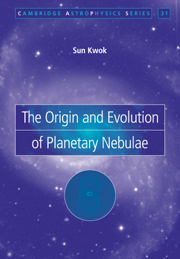Book contents
- Frontmatter
- Contents
- Preface
- 1 History and overview
- 2 Ionization structure of planetary nebulae
- 3 Nebular line radiation
- 4 Nebular continuum radiation
- 5 The neutral gas component
- 6 The dust component
- 7 Observations of the central star of planetary nebulae
- 8 Morphologies of planetary nebulae
- 9 Problems and questions
- 10 Asymptotic giant branch stars – progenitors of planetary nebulae
- 11 Evolution of the central stars
- 12 Formation of planetary nebulae
- 13 Dynamical evolution of planetary nebulae
- 14 Protoplanetary nebulae – the transition objects
- 15 Evolution to the white dwarf stage
- 16 Distances to planetary nebulae
- 17 Comparison between evolutionary models and observations
- 18 PN in the galactic context
- 19 Chemical abundances
- 20 Planetary nebulae in other galaxies
- 21 Concluding remarks
- References
- Appendix List of symbols and abbreviations
- Subject index
7 - Observations of the central star of planetary nebulae
Published online by Cambridge University Press: 04 November 2009
- Frontmatter
- Contents
- Preface
- 1 History and overview
- 2 Ionization structure of planetary nebulae
- 3 Nebular line radiation
- 4 Nebular continuum radiation
- 5 The neutral gas component
- 6 The dust component
- 7 Observations of the central star of planetary nebulae
- 8 Morphologies of planetary nebulae
- 9 Problems and questions
- 10 Asymptotic giant branch stars – progenitors of planetary nebulae
- 11 Evolution of the central stars
- 12 Formation of planetary nebulae
- 13 Dynamical evolution of planetary nebulae
- 14 Protoplanetary nebulae – the transition objects
- 15 Evolution to the white dwarf stage
- 16 Distances to planetary nebulae
- 17 Comparison between evolutionary models and observations
- 18 PN in the galactic context
- 19 Chemical abundances
- 20 Planetary nebulae in other galaxies
- 21 Concluding remarks
- References
- Appendix List of symbols and abbreviations
- Subject index
Summary
Central stars of PN (CSPN) are difficult to study because of their faintness in the visible (due to their high temperature) and the contamination of their spectra by nebular emissions. Unlike stars on the main sequence (MS), for which there exists a unique relationship between mass and effective temperature, CSPN undergo considerable changes in temperature over their short lifetimes. Although their masses do not change significantly, their surface abundances do change as the result of nuclear burning and mass loss. Assuming that the stellar winds from the CSPN are driven by radiation pressure, the mass-loss rate is mainly a function of T* and surface gravity (log g). In this case, the spectral classification of central stars can in principle be determined by three parameters: effective temperature, surface abundance, and wind strength. In this chapter, we discuss these three parameters in turn.
Determination of the temperature of the central star
Zanstra temperature
Zanstra (1927) developed the method to derive the central star temperature by comparing the nebular recombination flux with the stellar continuum magnitude. This method is based on the assumption that the number of Lyman continuum photons absorbed in the nebula is equal to the total number of recombinations to all levels excluding the ground state. Harman and Seaton (1966) used the nebular Hβ flux to estimate the total number of Lyman continuum photons, and they derived T* by comparing the Hβ flux with the stellar V magnitude.
- Type
- Chapter
- Information
- The Origin and Evolution of Planetary Nebulae , pp. 75 - 88Publisher: Cambridge University PressPrint publication year: 2000



